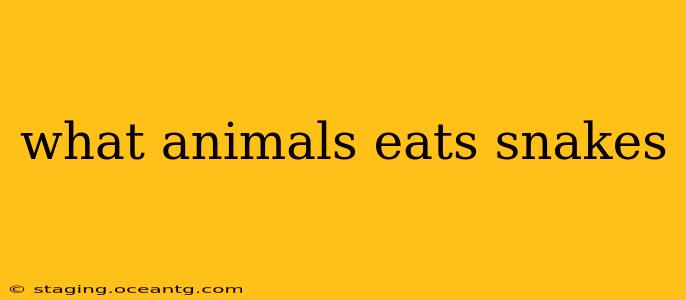Snakes, while often feared predators themselves, are also prey for a surprising variety of animals. Understanding their predators offers a fascinating glimpse into the complex web of life in various ecosystems. This guide delves into the diverse creatures that include snakes in their diet, exploring their hunting strategies and the ecological impact of this predator-prey relationship.
What are the main predators of snakes?
The primary predators of snakes vary greatly depending on the snake's size, location, and species. However, some common culprits include:
-
Birds of Prey: Eagles, hawks, and owls are skilled hunters capable of snatching snakes from the ground or trees. Their sharp talons and powerful beaks make them formidable opponents, even for venomous snakes.
-
Mammals: Many mammals prey on snakes, including mongooses (renowned for their snake-hunting prowess), foxes, badgers, and even larger primates like some species of monkeys. Their agility and strength allow them to overcome even large snakes.
-
Other Reptiles: Larger reptiles, such as crocodiles and some lizards, will readily consume snakes. Crocodiles, with their powerful jaws, pose a significant threat to snakes near water sources.
-
Amphibians: Larger frogs and toads, particularly those with specialized adaptations, can prey on smaller snakes.
-
Other Snakes: Cannibalism is surprisingly common among snakes, with larger snakes sometimes preying on smaller individuals of the same or different species.
What animals eat venomous snakes?
Hunting venomous snakes is inherently risky. However, some animals have evolved specific defenses or hunting strategies to overcome the threat of venom:
-
Honey Badgers: Known for their fearlessness and thick hides, honey badgers are surprisingly effective snake hunters, often facing down even highly venomous species.
-
Mongooses: Certain mongoose species possess a high degree of venom resistance, allowing them to effectively hunt and consume venomous snakes. Their quick movements and ability to dodge strikes are crucial to their success.
-
Hawks and Eagles: Some large birds of prey, with their aerial advantage, can successfully hunt venomous snakes, using their talons to subdue them before consumption.
What kind of snakes are eaten by other animals?
The type of snake preyed upon depends largely on the size and hunting capabilities of the predator. Smaller snakes are more vulnerable to a wider range of predators, while larger snakes generally face fewer threats. However, even large snakes are not immune to predation.
What eats baby snakes?
Baby snakes are incredibly vulnerable, facing predation from a wide range of animals. Many of the predators listed above also prey on young snakes, including birds, mammals, and even larger reptiles and amphibians. Their small size and lack of developed defenses make them easy targets.
How do animals protect themselves from snakes?
Animals that frequently encounter snakes have developed various defenses to avoid becoming prey:
-
Speed and Agility: Many animals rely on their speed and agility to escape snake attacks.
-
Venom Resistance: Some animals have evolved a degree of venom resistance, allowing them to survive snake bites.
-
Defensive Behaviors: Animals may exhibit defensive behaviors like hissing, spitting, or feigning death to deter snakes.
-
Protective Armor: Some animals possess natural armor, such as thick scales or hides, that offer protection from snake bites.
This overview provides a broad understanding of the diverse animal kingdom that includes snakes in their diet. The intricate predator-prey relationship showcases the balance and complexity of the natural world. Understanding these dynamics is vital to appreciating the ecological roles of both snakes and their predators.
